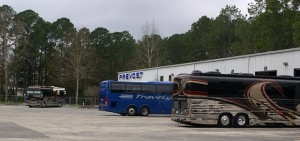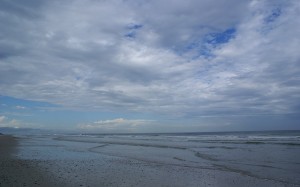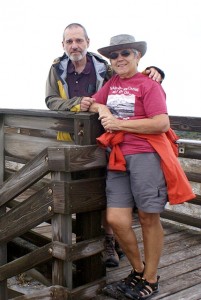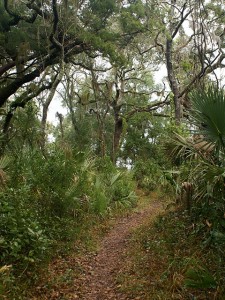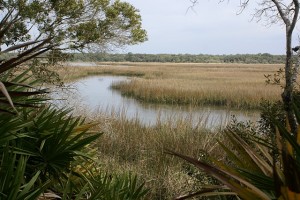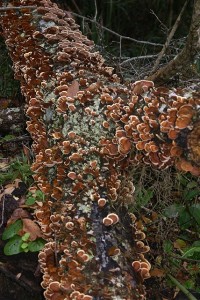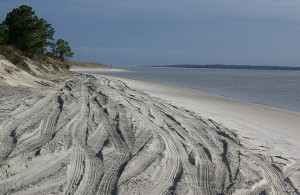The boots may have been made for walking, but the wheels were made for turning and it does not make much sense (to us) to own a motorhome and not use the motor to move the home around at least occasionally. Checkout time at Williston Crossings RV Resort is nominally 11 AM. We were planning to leave by then, but a call to Suncoast Designers at 9 AM caused us to push our departure time back. They suggested we not arrive until about 4 PM to make sure we had a place to park with hookups. That put our departure time target at 2 PM. We walked up to the office to make sure this would be OK. It was; we have been here a long time and been good residents, and no one was scheduled to go in to “our” site today.
Given some extra time we had not planned on, we went for one last, long walk around the RV resort. How different it looked and felt. The resort is turning over from long-term winter/seasonal use to short-term summer/vacation use and there were many empty sites. Eighty-nine rigs left yesterday. Many were Carriage 5th wheels that were part of the 70 rig Carriage Travel Club rally that was here all last week. But some were winter seasonal residents who have been dribbling out since April 1st and will continue to do so into May. We were not the only rig pulling out today. Our other neighbor, Sharon, is leaving this coming Sunday. A few rigs were pulling in, of course, but the departures currently exceed the arrivals on any given day.
When we returned from our walk I mixed up a batch of the concoction we use in the waste holding tanks (48 oz PineSol, 48 oz water, 1cup Calgon). I dumped the black-water tank and back-flushed it, followed by dumping the grey-water waste tank. I ran additional water through the drain hose and then disconnected the hoses and fittings and stowed them for travel. I reconnected the water softener and filled the fresh-water tank. Once that was done Linda helped me disconnect, clean, and stow the fresh water hoses and the water softener.
We tend to forego coffee and breakfast on travel days, but had a little of both this morning as we were not leaving right away. Because of the delay in our departure we did not have lunch. To pass the time I continued with travel preparations. The last time I had the coach batteries connected I noticed that the Pressure Pro TPMS (tire pressure monitoring system) was not reading one of the sensors (PS outside drive tire). We have a repeater for this system that I plan to install in the rear of the coach someday, but for now it gets attached to the rear view mirror of the car. I took care of that task and then decided to move the car up onto the patio next to passenger side of the coach. I left the ignition on to power the repeater and connected the coach batteries to power the TPMS receiver. After a few minutes all of the tire sensors were active and the tire pressures were OK for travel. I disconnected the coach batteries and put the car back in front of the coach.
At 1:30 PM we started our final travel preparations, clearing off the counters and moving stuff from the cockpit to the sofa, the bed, and the bedroom floor. At 1:45 PM I shut off the 240/120 VAC electrical power to the coach, disconnected the shoreline, and stowed it in the slide-out tray over the DS drive tires. I installed the screw-in cover for the utility port hole in the bay floor, and closed/locked the bay. I then checked the Magnum 4024 to make sure it had switched to inverter mode, which it had.
Once the shore power is cut we seem to develop an increased sense of urgency about leaving. I think this is due, in part, to the fact that I do not have the ZENA power generator operational yet, so our house batteries do not get charged while we are driving. That’s OK, up to a point; the battery bank was designed to be large enough to run the inverter and power reasonable loads for a reasonable length of time. But the sooner we leave, the sooner we arrive, and the sooner we arrive, the sooner we can plug back in to shore power. We have an auxiliary power plant, of course, so we always have the option of using that if needed. The other reason we are probably anxious to leave is more psychological. Once we are completely disconnected (physically) we are become disconnected mentally, although not necessarily emotionally. We are no longer “tethered” to that spot, and that means it is time to go.
I connected the chassis batteries, fired up the engine, and set the level low system to the driving position. While Linda moved the car to street I drained the auxiliary air tank using the nice dry air from the main engine air compressor. With John’s assistance we got the coach out of the site and lined up on the street. Linda pulled the car up behind the coach and we went through our procedure for hooking it up to the tow bar. We did our standard light check and found that the turn signals on the car were not working. A quick check of the connectors on both ends of the cable revealed a socket on the car end of the cable that was corroded. I used the awl on John’s Swiss Army Knife to clean it up. A recheck of the lights indicated that everything was working. After a final “goodbye” with John and Ali we were on our way.
Our departure delay meant we would be traveling SSW into the sun at the hottest part of the day. The air temperature was 85 degrees F when we left, and the engine ran slightly hotter than usual, indicating just above 195 degrees F on the coolant temperature gauge, so I decided not to run the coach air conditioning. The drive to Hudson was warm, but not unbearable. A cold front was approaching the gulf coast of Florida so we had increasing cloud cover as we progressed south and west towards the coast, which helped keep the cockpit from getting too warm.
We had a nice run from Williston to Hudson. We headed south out of Williston on US-41/US-27/FL-121. US-27/FL-121 split off to the west a mile south of town, made a sweeping turn to the left and then followed a nice straight line SW for 17 miles to its southern terminus at US-19. This stretch of FL-121 is straight but hilly. With the cruise control set the engine is very sensitive to hills. I always know we are on a grade, however slight, by the reaction of the turbo boost gauge and the pyrometers.
Most of the rest of trip was on US-19 except for the last three miles. Traffic was light until we got to Crystal River, which had slower speed limits, lots of stop lights, and lots of vehicles on the road. It opened up a bit after Homosassa Springs, but got congested as we approached Weeki Wachee where FL-50 ends at US-19. From Weeki Wachee to just north of Hudson traffic remained slow and congested with increasingly dense commercial use on both sides of the road and stop lights every mile. Just north of Hudson we turned east onto Little Road, which immediately swung south, and followed it for about two miles to New York Avenue, where we turned west and went another mile to Labor Place, the location of Suncoast Designers.
The coach ran fine, although the Check Engine Light came on almost immediately and was on more than it was off for the whole trip. That did not surprise me as we had not done any work over the last couple of months to fix the fuel temperature sensor voltage problem that is apparently setting a fault code in the DDEC II. I had hoped that the repairs we made in the dashboard wiring harness would fix the speedometer/odometer problem, but they did not; the gauge sat on zero for the whole trip. The left pyrometer (exhaust gas temperature) gauge, however, was much more responsive and tracked the right pyrometer gauge much more closely than it ever had before. It appears that the wires we repaired were for this gauge rather than the speedo/odo.
Once we pulled in to Suncoast Designers we pulled to the side of the road, so as not to block traffic, and unhooked the car. While Linda parked the car I found the office and checked on parking arrangements. Suncoast Designers has at least a dozen RV sites with water and 50 A electric hookups. The only one open was a somewhat tight spot between two other large Class A motorhomes that required me to back in. The maneuver was made more difficult by the fact that the road in front of the sites had a curb on the far side and was not wide enough to allow me to swing the front end without scrubbing the front tires. I repositioned the coach so that I was turning in from the driver’s side, but Linda and I could not figure out how to get the coach into the site. The guy next to us on the driver’s side offered to help. A former truck driver, he knew exactly what to have me do. Unlike some RVers, our pride is not injured by not knowing how to do something, and we gladly accepted his help.
I pulled past the site close to the front of his rig and then turned out to the passenger side, putting the coach at an angle to the open site. He had me back part way into the front of the site at that angle and then turn the steer tires full left to start to bring the coach around. He had me stop and then turn the steer tires full right and pull forward. Steer tires full left again and back up some more, then full right and pull forward. We repeated this one more time and finally had the coach lined up straight and centered between the coaches on either side without having hit either one! Linda was keeping an eye on the back of the coach the whole time (to make sure I did not hit anything) and guided me into our final position. We then leveled the coach and shut the engine down.
The outside air temperature was only in the upper 70’s, but it was 90 degrees F in the coach and the outside humidity was high. In spite of having nine windows that open, the three ceiling vent fans are not very effective at cooling down the interior under such circumstances. In theory we can run all three air conditioners on a “50 A” shore service, but we have tripped breakers before when doing that. (The issue is that circuit breakers are commonly designed to only carry 80% of their rated current on a continuous basis, so two of our A/C units plus a little bit of miscellaneous load can exceed 40 A on one of the legs.) Besides, as soon as I plugged in the Magnum 4024 was going to switch to charger mode and start recharging the house batteries.
I got the shore power connected and checked the Magnum 4024. It went into bulk charging mode and started charging the house batteries at 86 Amps. Since it is a 24 VDC charger, it was drawing ~1/5 that much AC current, or ~17 A, the equivalent of one of our air conditioners. The front (living room) and center (kitchen) A/C’s are on separate legs of the 240/120 VAC power supply, so we can run them at the same time. The bedroom A/C is on the same leg as the front A/C and the Magnum is on the other leg. We ran the front and center A/C’s along with Magnum and let the bedroom stay warm for the time being.
Suncoast Designers provides free WiFi for customers camped at their facility, but the signal we thought was theirs indicated it was “filtered” and we had not obtained the login information from the office before it closed. We used our Verizon MiFi instead and had a good, strong signal. I had a chance to ask our neighbor (helpful truck driver guy) later, and he said the open signal was the one they were using. Although it was a weak (one bar) “g” signal, our WiFi Ranger latched on to it without difficulty.
Linda needed a few grocery items and located a Publix grocery store on Little Road less than three miles from Suncoast Designer’s. As evening settled in we switched off the front A/C and turned on the bedroom unit. Linda reheated some of the leftover Sloppy Joe’s from the pot luck dinner the night before, and we had that on the skinny buns we have started using, along with a simple spinach salad and a few Fritos corn chips.
After dinner Linda sent e-mails to several of our new friends from WCRVR while I checked in to RVillage and took care of a few e-mails of my own. The overnight temperature was forecast to only drop into the upper 60’s with high humidity, and with rain starting before sunrise, so we decided to leave the rig closed up and the kitchen and bedroom A/C’s on all night. We rarely do this because of the noise and because we prefer fresh air, except when it is too warm and/or too humid. Considering that we had traveled less than 100 miles and been on the road just under two hours today, we both felt like it had been a very long day. As much as we enjoyed the social life at WCRVR, it was nice to not have anything to do but go to bed and get some rest.
